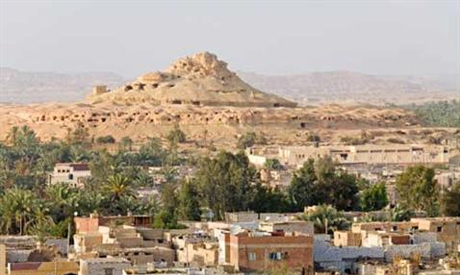
File Photo: A view of Siwa Oasis (Photo: Al-Ahram)
What makes the desert beautiful is that somewhere it hides a well, writes Antoine de Saint-Exupery in Little Prince.
Indeed Siwa Oasis is the best thing about the western desert. There are a million reasons that make Siwa beautiful. Walking in the footsteps of Alexander the Great and consulting the famous Oracle of Amun.
Watching the moon rise by a hot water well. The endless sea of sand that shimmers like soft satin and drifts into all the shades of gold as the day waltzes by. There is the magic of driving under (literally) one rain cloud and leaving the rain behind.
But the most beautiful aspect of Siwa is certainly its people. They speak their own dialect, wrote down their oral history and continue to celebrate an ancient harvest feast.
According to Ahmed Fakhry’s book Siwa Oasis, the old city of Siwa was located in Aghurmi next to the temple of the Oracle of Amun. Due to numerous attacks form Berbers and Bedouin during the middle ages, a thing that led the seven families left in Siwa to build a new fortified village up on a hill and call it Shali in 1203, read the Siwan Manuscript. The Manuscript was written over one hundred years ago by the head of the Abu Musallim family, the religious judge of Siwa. He recorded the oral traditions, origins and the war the oasis witnessed. His son and grandsons continue to do the same. A copy of the manuscript was given to prince Omar Tosson in the late twenties.
Set against the background of 1,300 feddans of palm, olive trees and greenery lies Al-Dakrour hill.
Al-Saha annual festival is usually held in mid-October or usually when it’s a full moon. It has several names, depending which era it represents. Nowadays it’s referred to as Al-Seyaha, (tourism), or the mulid of Sidi Soliman, their patron saint; which is a replacement for an ancient pagan feast of the harvest. “But in recent years the festival has lost much of its gay spirit since the government forbids the drinking of labgi or any other kind of wine in public,” writes Fakhry.
However, there was a big fight between the people living in the east and west of the oasis, and the Sheikh was the only one who could put a stop to it by inviting both parties to reconcile on Al-Dakrur hill. Since then it became the annual seyaha festival.
According to the National Folklore Archive, it was a Sufi sheikh that invited the two parties to eat and sufi zikr (religious songs) and after they reconciled, he asked them to make it an annual visit. From that day onwards, the Siwa population would gather up the hill for three consecutive days of festivity and food to celebrate.
Short link: